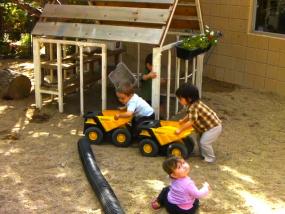Playing Toward Collaboration

This set of video clips shows a developmental progression in the strategies young children use to collaborate with peers. Infants establish a social connection and gain inter subjective awareness as they encounter peers who are similarly attracted to interesting objects and toys. One year old children use their growing understandings about their own intentions, and the intentions of others, to foster shared experiences based on imitation, often in the form of an action script such as “do as I do”, or “lead and follow”. Two year olds express a desire to play together, tune into peers with common interests, and cleverly invent ways to coordinate their actions (i.e., using familiar song lyrics to approximate a pretend play script for their toy animals). At three years of age, associative play verges on the cusp of collaboration as children engage in conversation fluidly, share the details of pretend play scripts, and make early efforts to invite their peers to join (i.e., “Guys, I put your breakfast right there if you want it.”). With experience, the three year olds’ strategies for posing an invitation become progressively more sophisticated, and the child may select an exciting and perilous moment to persuade a peer to join his dramatic play theme. As their social competence increases, three-year-old children work to coordinate groups of peers in socio-dramatic play. Resourcefully, they select familiar roles (family) that are easily enacted and require little negotiation, and often rely on spatial constraints (riding in a car, bus, train) to support and maintain the participation of group members. A sense of leadership emerges often, with one child inventing the pretend script and directing peers. At fours years of age, children begin to improvise more elaborated pretend scripts, lend greater dimension to dramatic roles by working to refine their symbols along several dimensions (props, action, verbal exchange), invent strategies for handling rejection, and negotiate with greater finesse when peers introduce different perspectives. As these strategies for collaborating continue to expand, the children’s focus shifts to establishing shared meaning, often using the terms: “and then,” “how ‘bout,” and “OK?” to negotiate. With increased competence, four-year-old children easily move in and out of the pretend play frame as they offer each other space to lead the story at alternating times.
Keywords: mixed ages, assorted materials, negotiation, symbolization, communication, self-other, pretend, child-child, cross-age development, videative
